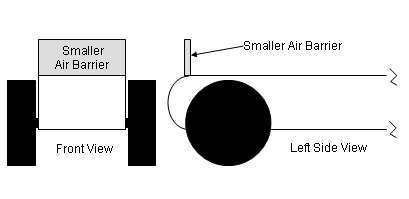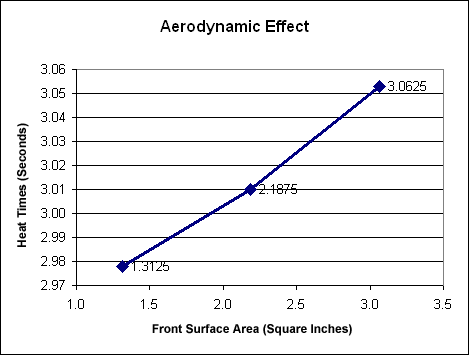As your recall, the big debates were introduced in 2002 and are as follows:
1. Best weight position – discussed in Volume 2, Issue 4
2. Number of wheels on the ground – discussed in Volume 2, Issue 4
3. Best wheelbase – discussed in Volume 2, Issue 6
4. Best lubricant – discussed in Volume 3, Issues 1 and 4
5. Value of canted wheels – discussed in Volume 3, Issue 6
6. Importance of aerodynamics(1)
We have now arrived at the last of the big debates; the importance of aerodynamics on pinewood derby cars. In this article, we will answer the following questions:
1. Does aerodynamics have any effect on pinewood derby cars?
2. If so, what steps can be taken to minimize the effect?
IS THERE AN AERODYNAMIC EFFECT?
I have always believed that the effect of air flow over a moving pinewood derby car was slight to none. This conclusion was drawn from reading several booklets (including speed tip booklets for sale over the internet), from comments made on web sites (e.g., “I’ll prove that aerodynamics play no part by running a plain block of wood in a race”), and from observing that the maximum speed of a pinewood derby car is only about 10 MPH. Certainly, air flow can’t slow down a car running at 10 MPH. Or can it?
But then I reviewed some (unpublished) testing done by Michael Lastufka and found that a distinct aerodynamic effect was measured. So I decided to find out for myself.
EXPERIMENT
In order to measure the effect of aerodynamics, I used a test car (previously described in Volume 3, Issue 6). The car is 3/4 inch high, but can be equipped with a small air barrier which brings the height at the front of the car to 1-1/4 inches (same as raw BSA block), or with a large air barrier which brings the height to 1-3/4 inches (see Figure 1).
Figure 1: Test Car Air Barrier
The car was raced once without a air barrier, then with the small barrier, and finally with the large barrier. This process was repeated 10 times, with all heat times captured by an accurate timer. All factors other than the air barriers were unchanged.
RESULTS
The results of the experiment are shown in the table below. In addition, Figure 2 shows a plot of the front surface area of the car versus the performance. As you can see, the air barriers had a distinct, and virtually linear effect on the car’s performance. In other words, the heat times decreased in proportion to the surface area decrease.
Front Size(Sq. In.)
No dam 1.3125
Small 2.1875
Large 3.0625
Figure 2: Surface Area versus Heat Time
Thus, this experiment shows that there is an aerodynamic effect with pinewood derby cars, and that the effect is significant.
COMPARISON STUDIES
As a comparison, here are two other studies that show similar results:
1. A several year old study which measured a block shape against an aerodynamic shape. The results indicate a 0.027 decrease in heat time for the aerodynamic car versus the block car.
2. In the unpublished study by Michael Lastufka mentioned earlier, two sizes of front surface areas were used. The smaller front surface was 2.6 square inches, while the larger front surface was 7.6 square inches. The results were that the smaller front surface outperformed the larger front surface by 0.078 seconds.
MINIMIZING THE EFFECT
Now that an aerodynamic effect has been demonstrated, how can the car builder minimize the effect? Here are several thoughts:
1. Low-profile cars (smaller surface area as viewed from the front of the car) will tend to outperform higher-profile cars.
2. Cars should taper from a smaller surface area in the front to a (possibly) larger surface area in the rear.
3. Edges running across the car should be rounded or tapered.
4. Wings, sails, flags, pennants, etc. add to the surface area, thus they tend to decrease performance.
5. Unfilled holes (major holes) can catch air and slow down a car.
CONCLUSION
One of the fun aspects of participating in a pinewood derby race is seeing the wide variety of cars that are entered. This article is not meant to stifle that creativity, but simply to make the builder aware that aerodynamics do play a role in car performance. By recognizing this fact, car builders can make adjustments in the car profile that could pay big dividends at the finish line.
(1) Aerodynamics – As used in this article, aerodynamics refers to the effect of air on the movement of a pinewood derby car.
From Pinewood Derby Times Volume 3, Issue 9
To subscribe to this free e-newsletter, please visit:
www.maximum-velocity.com/subscribe.htm
(C)2012, Maximum Velocity, Inc. All rights reserved.
www.maximum-velocity.com


